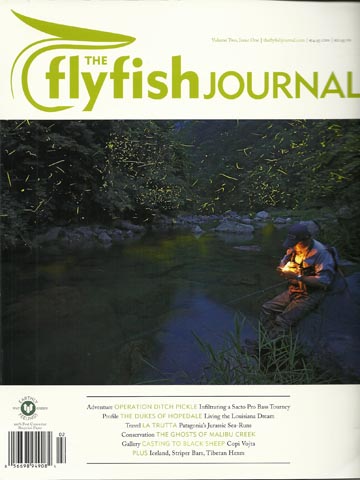Just under six hours the tide comes in and it’s high tide; just under six hours later it’s low tide and the water disappears. If it weren’t for those few minutes, the tide would be every six hours like clockwork. But it’s not. You could use charts to track its ebb and flood, but the best way is probably just to head to the shore and look.
When the water runs out, the bars show up. To a fisherman, it’s like finding the Lost City of Atlantis. We drop the air pressure in our tires to 12 PSI, shift into 4-low, and run our trucks on the beach as far as we can. I have an old Jeep CJ-5 I use for that very purpose. The frame is rotted out and one time I stuffed my foot through the rusted floor board while stomping the clutch.
I like everything about the beach-the bars, breaks, ocean holes, even the seals. Carole King was probably standing on sand when she wrote about feeling the earth move beneath her feet. I like the birds best-laughing and black-backed gulls, terns picking sandeels from shallows-and sometimes spend hours watching them dive on bait brought to the surface by pods of bass.
The fall is the best time for bird watching when the gannets and shearwaters show-enormous flocks spread out for miles. They fly higher and higher, searching all the while until they tuck their wings and plummet a hundred feet to the ocean below. You’d figure the impact would hit them like a load of high brass 6s, but they have air sacks in their necks and faces to cushion the blow.
On warm summer days the winds blow west-southwest, temperate and welcoming. The cloud ceiling is high, and the eggshell sky is mottled with puffy white cotton balls. Sometimes, when the winds shift, you’ll see mare’s tails splashed around like a painter gone mad. In late summer the wind starts to shift to west-northwest, bringing a Canadian chill-a woodcock wind, and after the ‘doodles move out, the ducks and geese follow.
A soft, southwest wind and dropping tide on a quarter moon makes the ocean lay down-calmer than a bathtub. When you’re on a beach and look out at the horizon, you’d swear it was 5o miles away instead of the eight or nine it really is. Give it a few days; it’ll change. When the winds shift east-northeast–dropping the tide–you wouldn’t be surprised if someone told you the horizon is a mile away, if that. And fortunately, it pushes the fish up the beach, where you’ll see them in the wash right at your feet.
I like to follow the advice of old-time anglers: “Fish points on full and new moons; fish coves on quarters.” Bait stages in coves during half moons and moves on full moons-silversides, sandeels, glass minnows, herring, peanut bunker, anchovies, mullet, and butterfish. Their cycle predicts good fishing. Bass and bluefish lie in wait to pin them against structure, the surface, wherever they can. Anglers just need to get there before the fish.
There are many types of bars, and they change year to year. My favorites are the offshore bars that run parallel to the beach. In the winter, they are meant for surfing, in the summer, fishing. With hard current running on both sides, offshore bars are like small islands, and sometimes the water between the beach and bar is chock-a-block with bass. Other times the fish are on the outside edge. I’ll tug on my wetsuit and paddle out. Surrounded by schools of stripers, I’m reminded of my favorite childhood game: Cowboys and Indians.
Onshore bars connect with the beach. They are far more civilized, requiring nothing more than a long walk. Most run at angles set by the dominant current. I’ll start working out an onshore bar a few hours before low tide, going as far as I can, and then wander back as the tide floods. Sometimes the fish are nowhere to be found, which generally means Land ho! and onto another.
Bull-nose bars look like an upside-downletterU.They’re easy to fish, but often are devoid of life-not reaching far enough into the ocean. Sometimes you’ll find bass and blues in the lee; other times they’re feasting on the windward edge. I always let my first cast sweep over the sand and into deeper water, waiting for the dull tug that will make it worth my while. When fish are tight to the beach, I don’t have to cast much further than my feet.
Few events are as frustrating as watching a large school of bass range just beyond your best cast. A few years back, I watched a desperate angler borrow a kid’s inflatable raft and paddle past the beach break. The cheap plastic bottom tore out before he ever got off a cast, and he returned to shore soaking wet and laughing. Later, I walked him to the bar at the top of the hill and bought us both a whiskey. Any man with guts like that deserves a drink.
From Chatham west you’ll find fast fish on the beaches: bonito, false albacore, Spanish mackerel, and occasionally bluefin tuna that like the warmer,Gulf Streamwater. When I see a school of bonito or albies racing down a beach edge, spraying silversides and anchovies on the drop-off, it’s pure magic. A hooked fish tears away, stops, then races right back, forcing you to back up the beach while reeling-all to keep them from spitting the fly. When one finally hits the sand, it’s cause for celebration.
Just under six hours, the tide comes in and it’s high tide; just under six hours later, it’s low tide and the water disappears. Just ask any angler or surfer-they’ll tell you. Better yet, head out to the beach break and see for yourself. The only way to learn anything about the ocean is to head to the shore and look.


This is amazing, poetry, science, the color of life on the ocean shore. Beautiful, well done.